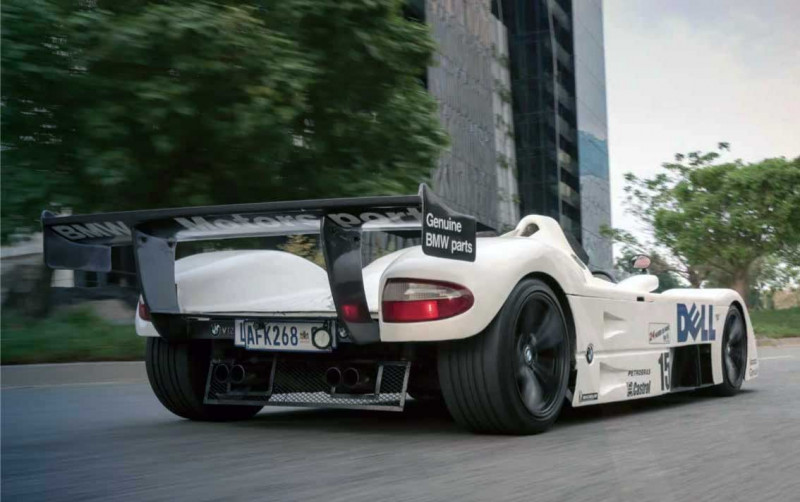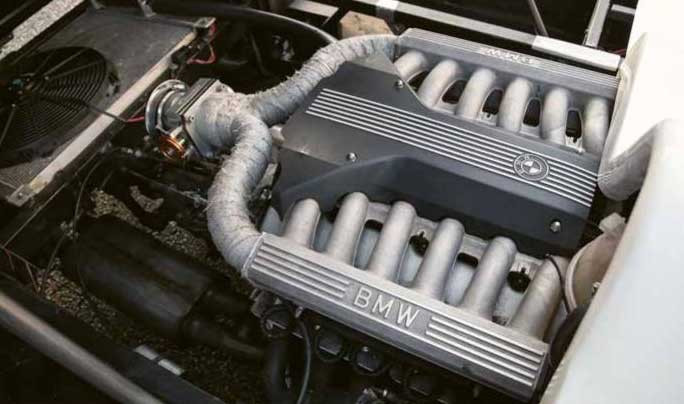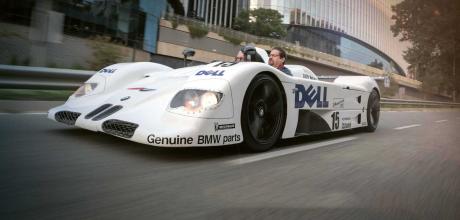1999 BMW V12 LMR Recreation - BMW M73TUB54 engined
We get up close and personal with one man’s passion project: a home-built Le Mans racecar for the road. Words by: Stuart Johnston. Photos: Jay Groat.
THE REP
Homemade Le Mans racecar for the road
The harsh bark of the V12 echoed off the tall buildings in the early morning and as the BMW LMR flashed past, it transported me back to another time, another place. Back to 1999, the final days of the 20th century, and a series of public roads linked by racetrack at the Circuit de la Sarthe, more commonly known as Le Mans. In one of the most dramatic races in the history of the famous 24-hour event, a Mercedes flew off into the trees lining the circuit, a Toyota challenging for the lead burst a tyre at over 300 km/h on the main straight in the final hour and, almost unnoticed, a BMW scored the Bavarian company’s only victory at this epic race. I was lucky enough to be a spectator at that event.

Fast forward to 2021 and the car in question was not the exact Le Mans winner, but a road-going tribute to the car that saw Yannick Dalmas, Jo Winkelhock and Pierluigi Martini go into the Le Mans history books. This one was not fettled in the hallowed race workshops of BMW Motorsport in Munich, but in a humble garage in Kempton Park, just a few kilometres from Johannesburg’s O.R. Tambo International Airport.
It’s a stunning sight, and seeing it on a deserted street in Sandton with dramatic modern glass backdrops, the thought crossed my mind that perhaps a street race here for classic sports prototypes has more than a little merit. Not that Johan Ackermann’s LMR tribute is a racer. It is fully kitted out for the road with lights, indicators, treaded tyres and suspension that rides the bumps beautifully. “A few of my racing friends tried to encourage me to fit a full rose-jointed racing setup but that wasn’t what I wanted,” explained Ackermann. “I wanted a car that resembled the beautiful BMW LMR as closely as possible but a car I could enjoy on a Sunday cruise. Of course, it had to be able to travel long distances, too. Its first shakedown was a trip to the George Motor Show and back, a round trip of 2500 km.

A few years before the BMW build, Johan – or Akkie as he is commonly known – had constructed an impressive tribute to the Mercedes-Benz C9 Le Mans racer, which won the event in 1989. “I am a huge Mercedes fan but I also have a big affinity for BMW. I tested some car components for BMW a few decades ago and worked for the late, great Tony Viana, BMW’s most famous saloon car racer from the ’80s and early ’90s.”
Johan had no access to construction drawings for the BMW LMR V12. The manufacturer had built only a handful of these machines, entering a two-car team and after they retired the cars, they were not offered for sale to private owners. So, as he did with his previous Mercedes racer, Johan relied almost entirely on a 1:18 scale model of the car he purchased from a specialist model car shop. He then scaled all the dimensions up to full size and set about laying the groundwork for the project.
“With my Merc racer, I used a V6 engine for the car, whereas the original C9 had a twin-turbo V8. This time, with the BMW, I was determined to use a V12, to keep it closer to the spirit of the original. We sourced a BMW 5.4-litre V12 engine from a 1990’s 7 Series and for the gearbox, I used a five-speed item from an E36-generation 3 Series turbodiesel model. We used a BMW automatic bellhousing to mate the engine and gearbox, and this is connected straight to the 7 Series diff with a coupling, so there’s no propshaft.
“All the other running-gear components are pretty much 7 Series BMW from the 1990s, including the suspension and steering. The brakes are from a 1990’s BMW M5 and the wheels are M4-spec BMW alloys with a lovely black Y-spoke pattern.”
The next step was to lay out and build the basic chassis. For this, Johan used two main frame rails of square steel tubing 35 mm by 76 mm in size, with a 2mmwall thickness. Johan said at this point he decided to stretch the wheel-base slightly compared to the original racecar because he wanted it to be comfortable to drive and enjoy a bit more cockpit space.
The V12 engine sits in the frame and does not act as a stressed member of the chassis. All the suspension and steering pick-up points are as per BMW 7 Series specs, so the geometries haven’t been altered and provide adequate spring and damping travel with no trace of bump steer. With the chassis laid out and dummy wheels in place, it was time to construct the bodywork. Here Johan has an interesting technique that doesn’t rely on creating plugs and male-to-female moulds. Rather, he creates the desired shape of the body in place on the chassis using industrial foam off-cuts which he bonds together. He then shapes the foam to the precise form he is after. It’s a painstaking process, involving many, many hours of labour.
Once he is satisfied that all the surfaces are perfect in terms of the correct shape and ripple-free, he lays on fibreglass matting to create the final body shape. He uses rollers to ensure there are no air bubbles.
The body is created in one piece and only once the fibreglass has cured, does he create the shut lines to separate the cockpit area from the nose section and engine cover. The foam beneath the fibreglass is then cut away; although, in the case of the BMW, he left the foam in place in the side sections as an added form of side-impact protection.
The rest of the job involved sourcing an aftermarket ignition to get the 250 kW BMW V12 running correctly, which was done using Spitronics management, installing an adequate cooling system, a (loud) exhaust created by the well-known TNT company and adding seats, a small steering wheel, lights, indicators and other road-friendly items. Accompanying Johan on that maiden trip to George was Manie Coetzee, a close relative. Manie assisted Johan with the building of the car after Johan had seriously injured his right hand in his work as an aircraft air-conditioning specialist. Until this point, Manie had no previous car-building experience, whereas Johan was already well known for the Mercedes-Benz C9 Le Mans tribute car he built a few years earlier. Apart from the physical assistance, Manie says he helped Johan achieve the shape the car is today because two eyes are better than one in assessing form and function.
“It was so satisfying,” says Manie. “It took us just under a year to finish, working weekends and public holidays. With my IT experience, I was happy to organise an electric system for lights and indicators with minimal wiring.”
As for Johan, he has no doubt the car will run way in excess of 250 km/h, but he is content to merely explore the car’s acceleration and generally cruise at normal highway speeds.
“It’s comfortable on the road, with a lovely ride and it stops very well,” says Johan. “For long trips, I use a crash helmet but for trips of under 100 km, it’s fine to drive without a helmet and enjoy the fresh air and sounds from that V12.”
01 Can you believe it, Ackermann’s sole frame of reference was this 1:18 scale mode of the Le Mans winner.
02 Powerplant is a BMW V12 sourced from a 1990’s BMW 750i E38.
- 1999 BMW V12 LMR Recreation
- Where we drove it: Sandton
- Engine: 5,4-litre, V12, petrol M73
- Transmission: 5-speed manual
- Max Power: 326bhp (250 kW) @ 5200rpm
- Max Torque: 550 N.m @ 4100rpm
- 0-62mph 0-100 km/h: 4,80 sec est
- Top speed: 250 km/h est
- Wheelbase: 2 850 mm
- Tyres: 255/40 R18 (f), 285/35 R18 ®
- Weight: 1 180 kg
ON TO THE NEXT ONE …
A year or so after finishing the BMW LMR V12, Johan is now well on his way with his next project; a Mercedes-Benz C11 tribute car, the successor to the C9 Merc Johan built a few years back. “I learnt a heck of a lot with the C9 and applied those lessons to the BMW LMR. With the C11, I have much more information as I have been able to source original drawings and specs from the owner of one of the surviving C11 racers in the UK. This chap has been extremely helpful and supportive of my latest project.”
Johan is going the whole hog and using a twinturbo V8 Mercedes-Benz engine installation, similar to the original racer’s power unit. He has already started forming the shape of the car and built the basic chassis.
The C11 is the car that dominated the 1990 World Endurance Championship. It is also the car that gave young Michael Schumacher his first taste of serious racing horsepower, when he debuted in the car at the 1990 round of the championship, at the Nürburgring. Funnily enough, this author just happened to be in Germany for that race, too. The story appeared in CAR’s December 1990 issue.
- 01 This BMW V12 LMR tribute is fully street legal. Exhaust note is wild!
- 02 Look familiar? Beautiful black rims are from a BMW M4.
- 03 Racecar on/off switch adds competition authenticity.
- 04 Nose and headlight treatment is faithful to the original.
- 05 Minimalist cockpit furnishings include small-diameter, flat-bottomed steering wheel.
- 06 Johan chose to stretch the wheelbase slightly to provide a more comfortable cockpit for long-distance drives.


